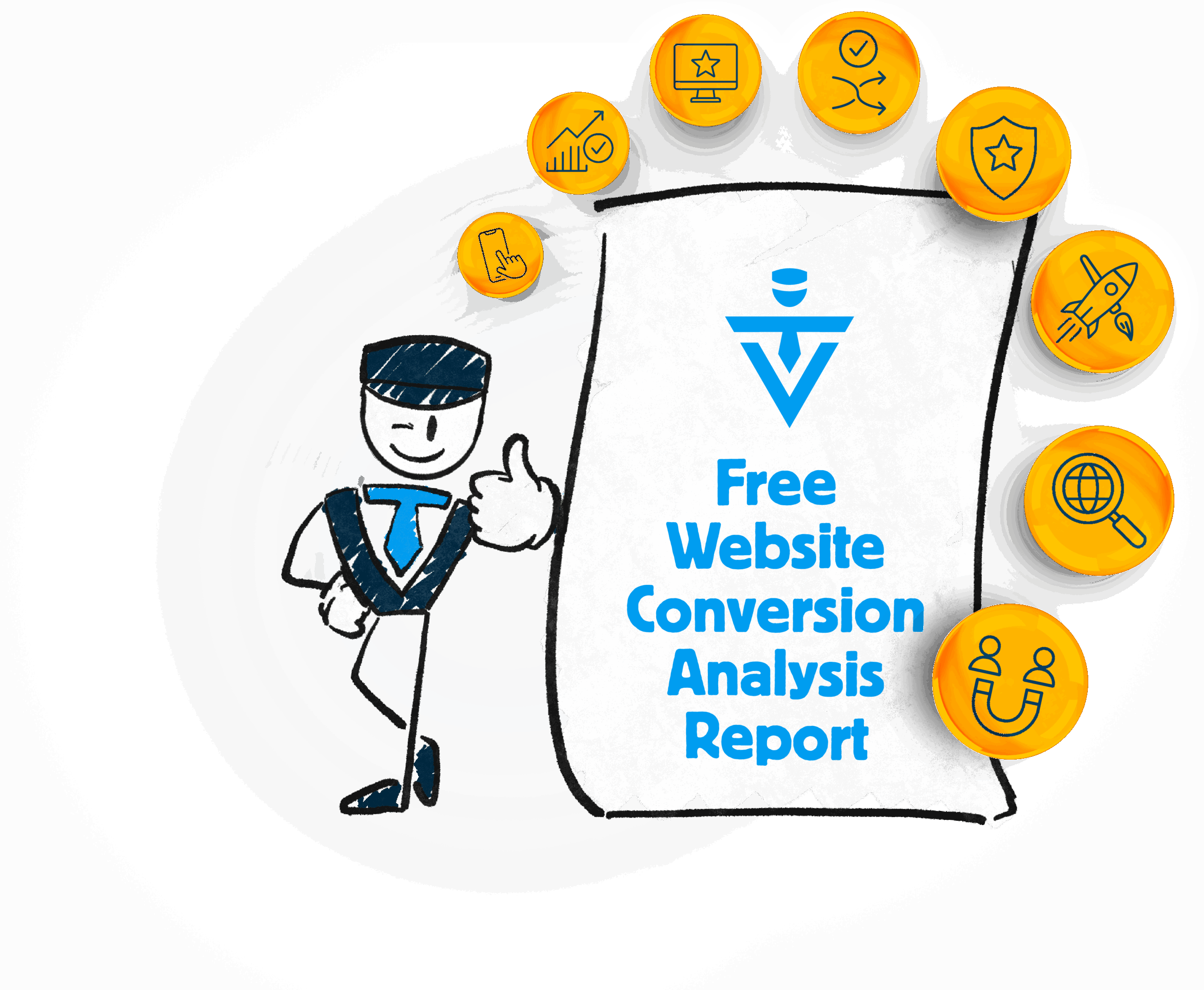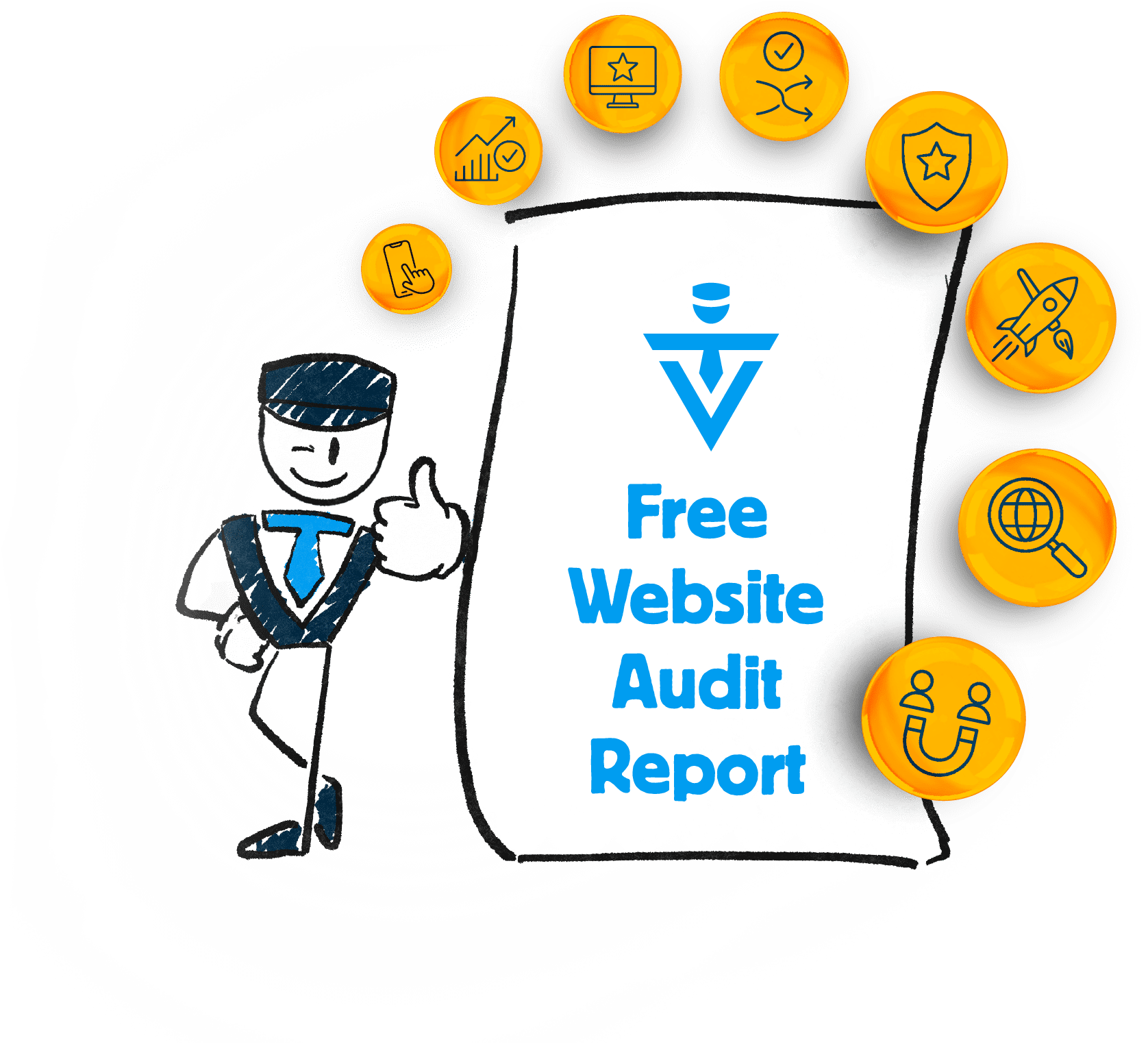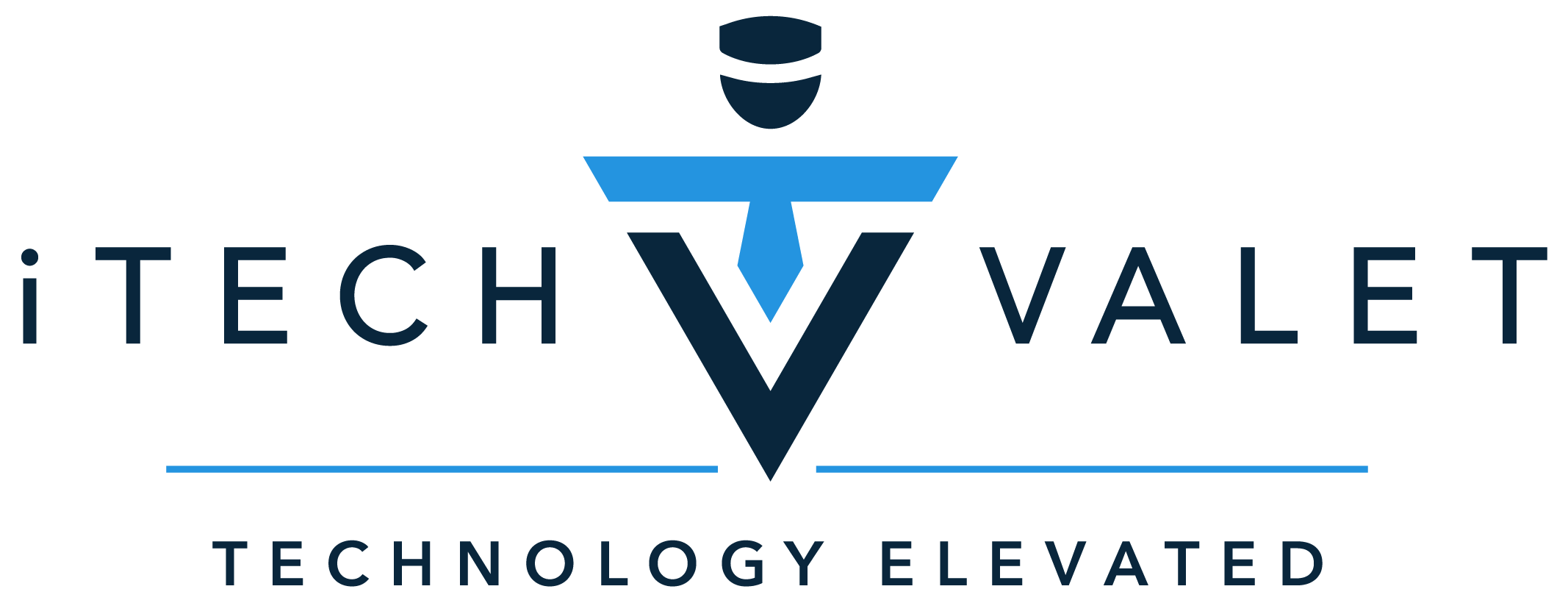
What Lead Magnets Work Best for Chiropractors? (Templates + Examples)
![]() by Gerek Allen ~ Last Updated: October 31st, 2025 ~ 9 Min Read
by Gerek Allen ~ Last Updated: October 31st, 2025 ~ 9 Min Read
![]() by Gerek Allen
by Gerek Allen
~ Last Updated: October 31st, 2025 ~
~ 9 Min Read ~
For solo practitioners or small chiropractic practices, your best lead magnets are specific, actionable resources that solve one problem your ideal patients face right now—like a "5-Minute Desk Stretch Routine" video, a back pain relief checklist, or a posture assessment quiz.
These work because they provide immediate value without requiring a commitment, letting potential patients experience your expertise before booking an appointment.
Here's what's crazy: Most chiropractors think they need fancy, expensive marketing to attract new patients. But the practices filling their schedules consistently are the ones giving away simple, helpful resources that solve real problems.
A well-designed lead magnet does three things simultaneously. It captures contact information from people actively looking for help. It positions you as the trusted expert in your area. And it starts nurturing relationships with potential patients who aren't ready to book today but will be in a few weeks or months.
If you're a solo chiropractor or running a small practice (1-3 doctors), start with a back pain checklist or posture guide. If you specialize in sports injuries, create an injury prevention resource for athletes. If you treat a lot of office workers, a desk ergonomics guide will fill your calendar faster than any generic "wellness tips" PDF.
Let me show you exactly which lead magnets convert browsers into booked appointments.
Why Lead Magnets Are Your Practice's Secret Weapon

Most website visitors aren't ready to book an appointment during their first visit to your site.
They're researching. Comparing options. Trying to figure out if chiropractic care is even right for them. Maybe their pain isn't bad enough yet. Maybe they're nervous about the cost. Maybe they just want to learn more before committing.
Without a lead magnet, these potential patients disappear forever. They close your website and move on. You'll never hear from them again, even though they were actively looking for help with the exact problems you solve every day.
That's money walking out the door.
Lead magnets solve this by offering something valuable in exchange for an email address. You're not asking for a commitment. You're not pushing for a sale. You're simply saying, "Here's something helpful. If you want it, just tell me where to send it."
Once you have their email address, everything changes. Now you can stay in touch. You can send them helpful tips. Share patient success stories. Answer common questions. Build trust over time until they're ready to book.
Lead Magnets Build Your Most Valuable Business Asset
Your email list is the only marketing asset you truly own.
Facebook can change its algorithm tomorrow and cut your reach in half. Google can update its ranking factors and drop your website three pages down. Instagram can ban your account for reasons you'll never understand.
But your email list? That's yours. Forever.
Nobody can take it away from you. You control when you communicate, what you say, and how often you reach out. It's direct access to people who've already shown interest in what you offer.
And here's what most chiropractors miss: The average patient isn't ready to book for 30-90 days after their first website visit. If you don't capture their email, you've lost them before they even make a decision.
A strong email list means you're top-of-mind when they're finally ready. When their back pain gets worse. When their friend asks for a chiropractor recommendation. When they decide they're tired of living with chronic headaches.
Learn more about using email to stay connected with potential patients.
Lead Magnets Position You as the Local Expert
Here's the reality most chiropractors don't want to accept: Most people won't book an appointment the first time they visit your website.
They need time. They need trust. They need to be convinced that chiropractic care is worth their time and money.
Lead magnets start that conversation. They open the door. Then your follow-up emails continue building the relationship until booking an appointment feels like the natural next step.
This is how the most successful practices fill their schedules. Not by being pushy. Not by running more ads. By nurturing relationships with helpful content until potential patients are ready to become actual patients.
Discover how to attract new patients with a comprehensive marketing strategy.
Lead Magnets Let You Nurture Patients Until They're Ready
When someone downloads your lead magnet and it actually helps them feel better, something powerful happens.
They start seeing you differently.
You're no longer just another chiropractor competing for their attention. You're the expert who already helped them—for free. You're the one who understood their exact problem and gave them actionable solutions that worked.
That's positioning money can't buy.
Most chiropractors spend thousands on ads trying to convince people they're credible. You're building credibility by actually being helpful. By solving real problems. By demonstrating your expertise instead of just claiming it.
When these people are ready to book an appointment, who do you think they'll call? The chiropractor who ran an ad saying "We're the best"? Or the one who already proved they know exactly how to help?
The 3 Elements Every High-Converting Chiropractic Lead Magnet Must Have
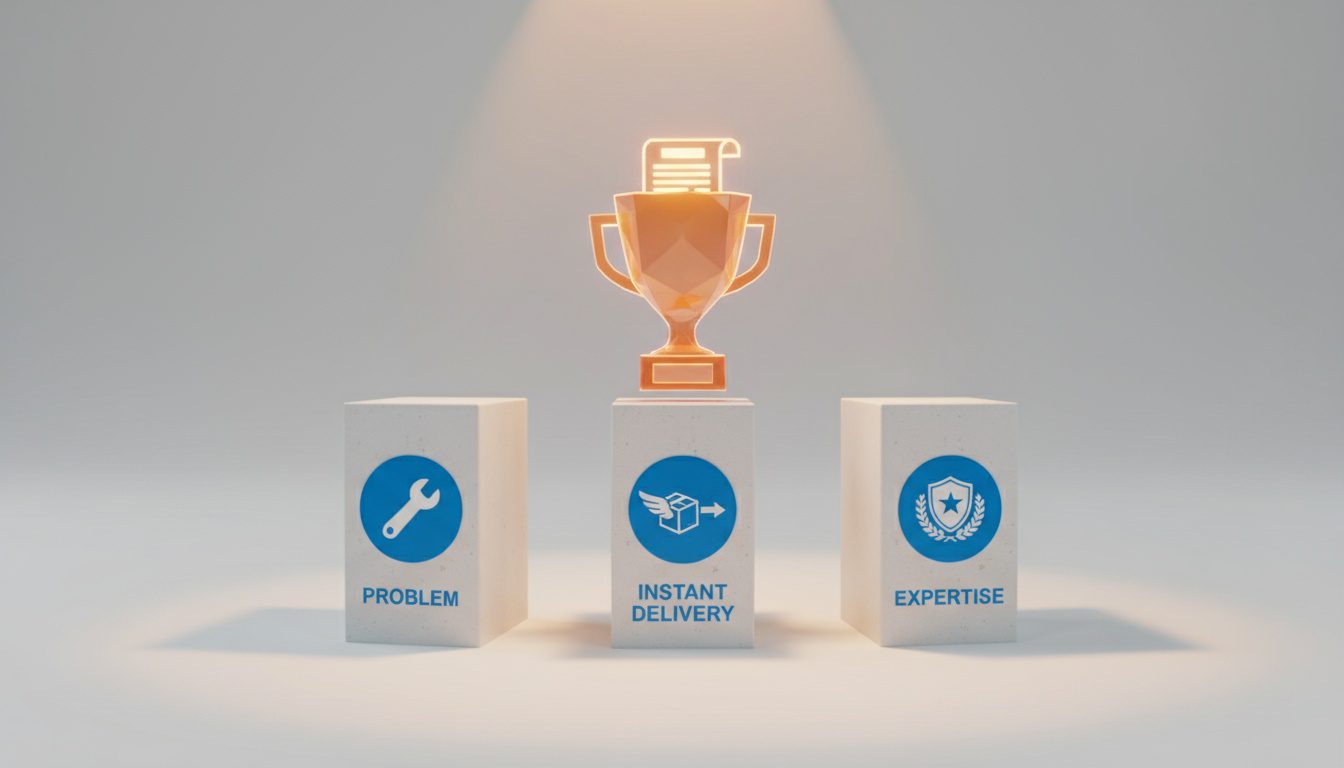
Not all lead magnets are created equal.
A blurry PDF with generic advice nobody asked for won't get you anywhere. You need something that makes people think, "Holy crap, this is exactly what I needed."
Here are the three non-negotiables for lead magnets that actually convert.
It Solves One Specific, Immediate Problem
The biggest mistake chiropractors make with lead magnets is trying to be too helpful.
They create a 47-page guide called "Everything You Need to Know About Spinal Health" and wonder why nobody downloads it.
Nobody wants everything. They want the solution to their specific problem right now.
Specific beats comprehensive every single time.
Instead of "How to Live Healthier" (too vague, gets ignored), create "5 Simple Stretches to Relieve Sciatic Nerve Pain in 10 Minutes" (specific problem, clear outcome, defined timeframe).
Instead of "Guide to Better Posture" (boring, generic), create "The Desk Worker's 2-Minute Posture Reset" (targets specific person, promises quick win).
The more specific your lead magnet, the more valuable it feels to the exact people who need it. You're not trying to appeal to everyone. You're trying to be irresistible to your ideal patients.
Think about the questions you hear every single day in your practice. What do patients ask about most? What problems bring them through your door? Use those as inspiration for your lead magnets.
It's Delivered Instantly (No Waiting, No Exceptions)
We live in an instant gratification world.
People want help now. Not tomorrow. Not next week. Not "within 3-5 business days." Right freaking now.
Your lead magnet must be delivered instantly via automated email. The second someone enters their email address and clicks submit, they should get a message saying "Check your inbox—your guide is waiting for you."
This is why digital formats dominate. PDFs, checklists, video tutorials, and online quizzes work perfectly because they can be automated. No manual work required from you or your staff.
The instant delivery does something else important: It proves you keep your promises.
You said, "Enter your email and I'll send you this helpful resource." They did. You delivered immediately. That small interaction builds massive trust because so many businesses fail at this basic level.
It Showcases Your Expertise and Professionalism
Your lead magnet is often the first real impression potential patients have of your practice.
It needs to look and feel professional.
Use your branding. Add your logo. Make sure it's easy to read and visually appealing. This isn't the place to cheap out with a Word document converted to PDF.
But here's what matters even more than how it looks: The content needs to actually work.
When someone tries your recommended stretches and feels a little relief, they immediately wonder what a full adjustment could do for them. When your posture tips help them sit more comfortably at work, you've proven you understand their problem.
That's when they become buyers. Not because you have pretty graphics, but because you demonstrated real expertise that created real results.
The combination of professional presentation and genuinely helpful content positions you as the obvious choice when they're ready for chiropractic care.
12 Proven Lead Magnet Ideas That Fill Chiropractic Practices
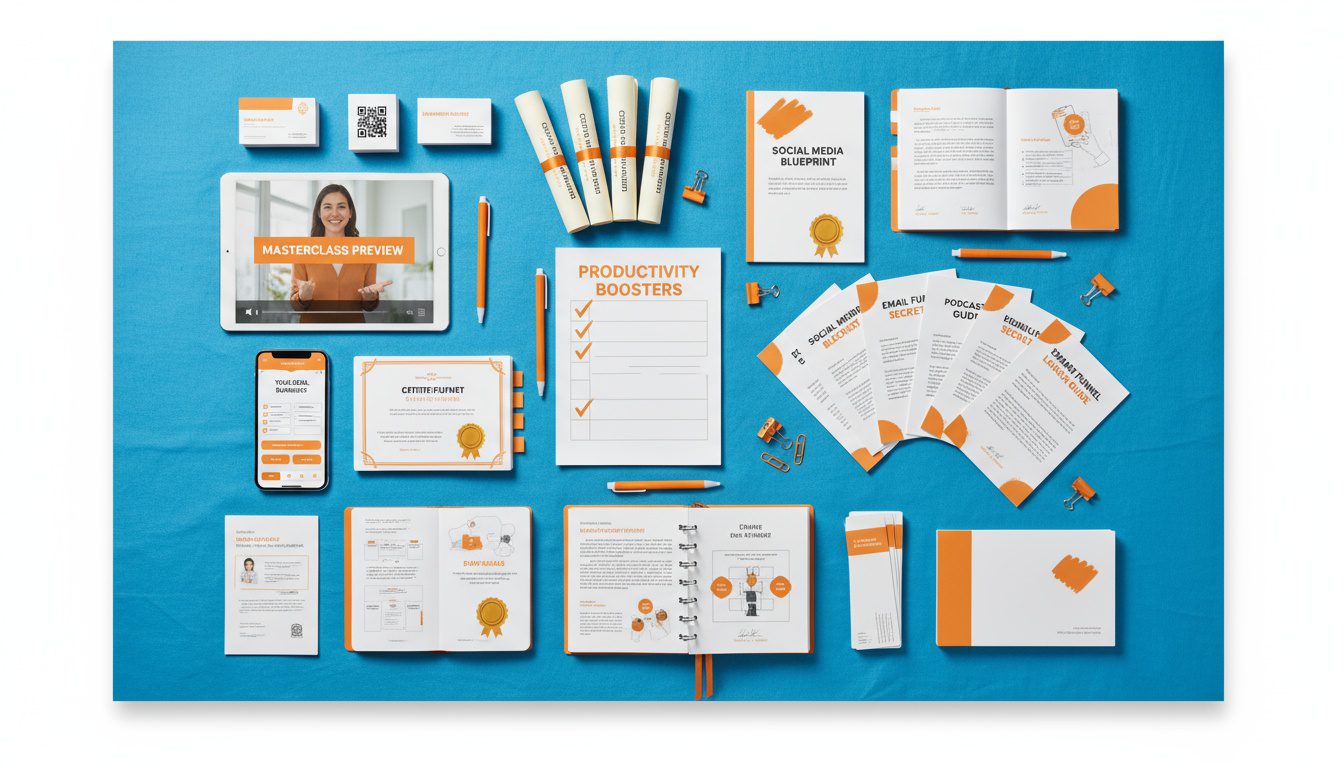
Stuck on what to create? You don't need to reinvent the wheel.
Here are 12 proven lead magnet ideas you can implement this week to start attracting qualified leads.
1. The Back Pain Relief Checklist (Quick Win)
This is the easiest, fastest lead magnet you can create—and it works incredibly well.
A simple one-page PDF checklist of daily habits for a healthier spine. Proper lifting techniques. Ideal sleeping positions. Simple posture checks people can do at their desk.
Why it works: It's instantly actionable. People can download it and start implementing tips within minutes. They get immediate value without having to read through pages of explanation.
Target audience: Anyone dealing with general back pain (which is basically everyone).
Time to create: 1-2 hours.
Best for: Solo practitioners who need something effective fast.
2. The Desk Worker's Posture Reset Guide (Niche Targeting)
So many of your potential patients sit at desks all day dealing with "tech neck" and lower back strain.
Create a visual guide specifically for them. Include pictures showing exactly how to set up their chair height, monitor position, keyboard placement, and mouse position for optimal ergonomics.
Add a "2-Minute Desk Reset" routine they can do every hour—simple stretches and adjustments they can do without leaving their chair.
Why it works: It speaks directly to a massive, underserved demographic. Office workers know they have posture problems but don't know how to fix them.
Target audience: Remote workers, office workers, anyone sitting for 6+ hours daily.
Time to create: 2-3 hours.
Best for: Practices in business districts or areas with lots of corporate offices.
Promotion tip: Share on LinkedIn and in local business groups on Facebook to reach office workers where they spend time online.
3. The 5-Minute Morning Mobility Routine (Video Lead Magnet)
Video lead magnets build personal connections before someone ever meets you.
Film yourself demonstrating 4-5 simple morning stretches designed to wake up the spine and reduce stiffness. Keep it to 5 minutes. Make it something people can follow along with while still in pajamas.
Why it works: Video creates connection. They see your face, hear your voice, and watch you demonstrate proper form. It's way more personal than a PDF.
Target audience: Anyone dealing with morning stiffness (older patients love this).
Time to create: 1 hour to film and edit using your phone.
Best for: Chiropractors comfortable on camera who want to build personal connection.
Pro tip: Host it on YouTube, embed it on your website, and use it as a content piece that also serves as a lead magnet.
4. The Headache & Migraine Trigger Tracker (Problem Awareness)
Many people suffer from chronic headaches without understanding why.
Create a printable tracker that helps them log their diet, stress levels, sleep patterns, screen time, and activities. After two weeks of tracking, patterns emerge that help them identify triggers.
Why it works: It helps people self-diagnose their problem. Once they see patterns (headaches always after poor sleep, or after eating certain foods), your practice becomes the logical next step for treatment.
Target audience: Chronic headache and migraine sufferers.
Time to create: 2 hours.
Best for: Practices that specialize in headache treatment or have good success with migraine patients.
"Is Chiropractic Care Right for You?" Interactive Quiz (High Engagement)
Interactive quizzes are ridiculously engaging and highly shareable.
Use a free tool like Typeform or Google Forms to build a quiz that asks about their pain type, lifestyle, health goals, and previous experiences with healthcare. Based on their answers, provide personalized recommendations.
Why it works: Quizzes are fun. People love learning about themselves. And they're way more engaging than downloading another PDF.
Target audience: People on the fence about trying chiropractic care.
Time to create: 3-4 hours.
Best for: Practices with varied patient types who want to segment leads based on needs.
Shareability factor: Quizzes get shared on social media. People tag friends and compare results. Free viral potential.
6. Free Virtual Posture Assessment (High-Intent Leads)
This is the highest-value offer you can make without being an in-person consultation.
Offer a free 15-minute video call where you assess their posture and provide personalized recommendations. Or create a self-assessment where they submit photos and you send back a Loom video with analysis.
Why it works: This generates incredibly qualified leads because anyone willing to schedule a video call or submit photos is genuinely interested in your services.
Target audience: High-intent prospects who are close to booking but need that final push.
Time investment: 15-20 minutes per assessment.
Best for: Practices with availability for consultations and strong conversion skills.
Warning: This takes more time than passive lead magnets, but the leads are gold. One assessment can lead to a $3,000+ patient lifetime value.
"Ergonomic Home Office Setup" Webinar or Video Training (Authority Building)
With remote work exploding, home office ergonomics is a massive concern—and most people are doing it completely wrong.
Host a free 30-minute webinar (live or pre-recorded) teaching people how to create a pain-free workspace. Cover chair selection, desk height, monitor positioning, lighting, and movement breaks.
Why it works: Webinars position you as the authority. You're teaching, not selling. But you're demonstrating expertise that makes booking an appointment the obvious next step.
Target audience: Remote workers, entrepreneurs, freelancers.
Time to create: 4-6 hours for first webinar; reuse indefinitely.
Best for: Practices comfortable presenting and wanting to establish authority in their community.
Promotion: LinkedIn ads and local business Facebook groups are gold mines for this.
8. Patient Success Story Case Study (Social Proof)
Stories sell better than features ever will.
Turn a patient success story into a short ebook or PDF. Explain their problem, your treatment plan, the timeline, and the transformation. Use real results (with permission).
Example title: "How We Helped a Local Runner Get Back on the Trail After 6 Months of Sciatic Pain"
Why it works: Stories help people see themselves in your patients. They think, "That's exactly my situation—if it worked for them, it'll work for me."
Target audience: People with similar conditions to your featured patient.
Time to create: 2-3 hours.
Best for: Practices with compelling patient transformation stories (and patient permission to share them).
9. The Complete Guide to Supplements for Joint and Spine Health
People are constantly confused about supplements—what works, what's snake oil, what's worth the money.
Create a straightforward guide explaining the science behind common supplements. Cover glucosamine, turmeric, vitamin D, magnesium, omega-3s. Be honest about what research shows and what's just marketing hype.
Why it works: Honest, helpful advice builds immense trust. You're not trying to sell them supplements. You're educating them about their options.
Target audience: Health-conscious individuals, people already interested in natural approaches.
Time to create: 3-4 hours.
Best for: Practices that take a holistic approach or have supplement recommendations as part of treatment plans.
10. New Patient Special: Discounted First Visit Coupon (Direct Action)
This is the most direct lead magnet possible.
Offer a "New Patient Special"—discounted first consultation, exam, and adjustment. Frame it as an introductory offer for first-time patients.
Why it works: For people ready to take action, this removes the final barrier. It's a low-risk way to try your services.
Target audience: Action-takers, price-sensitive patients, people close to booking.
Time to create: 30 minutes.
Best for: Practices with open schedule spots or seasonal slowdowns.
Warning: You'll attract some bargain hunters who won't return. But you'll also capture high-quality patients who just needed that final nudge.
11. The "Sleep Better Tonight" Pillow and Sleeping Position Guide
Poor sleep quality is epidemic, and many people have no idea their sleeping setup is causing their back and neck pain.
Create a visual guide showing proper sleeping positions for different pain types, how to choose a supportive pillow, and simple bedtime stretches that improve sleep quality.
Why it works: Everyone wants better sleep. And when your tips help them wake up with less pain, you've created a believer.
Target audience: Anyone with sleep issues or morning pain.
Time to create: 2-3 hours.
Best for: Practices that frequently treat neck pain and discuss sleep positioning with patients.
12. Sports Injury Prevention Checklist for [Specific Sport]
If you treat a lot of athletes or weekend warriors, create sport-specific injury prevention resources.
Examples: "Runner's Injury Prevention Checklist," "Golfer's Mobility Routine," "CrossFitter's Recovery Guide."
Include warm-up routines, common injuries in that sport, preventive stretches, and warning signs they need professional help.
Why it works: Super targeted. If someone's searching for running injury prevention and finds your guide, you're immediately positioned as the chiropractor who understands their specific needs.
Target audience: Athletes and active individuals in specific sports.
Time to create: 2-3 hours.
Best for: Practices specializing in sports injuries or located near gyms, running clubs, golf courses.
How to Create Your First Lead Magnet (Step-by-Step)
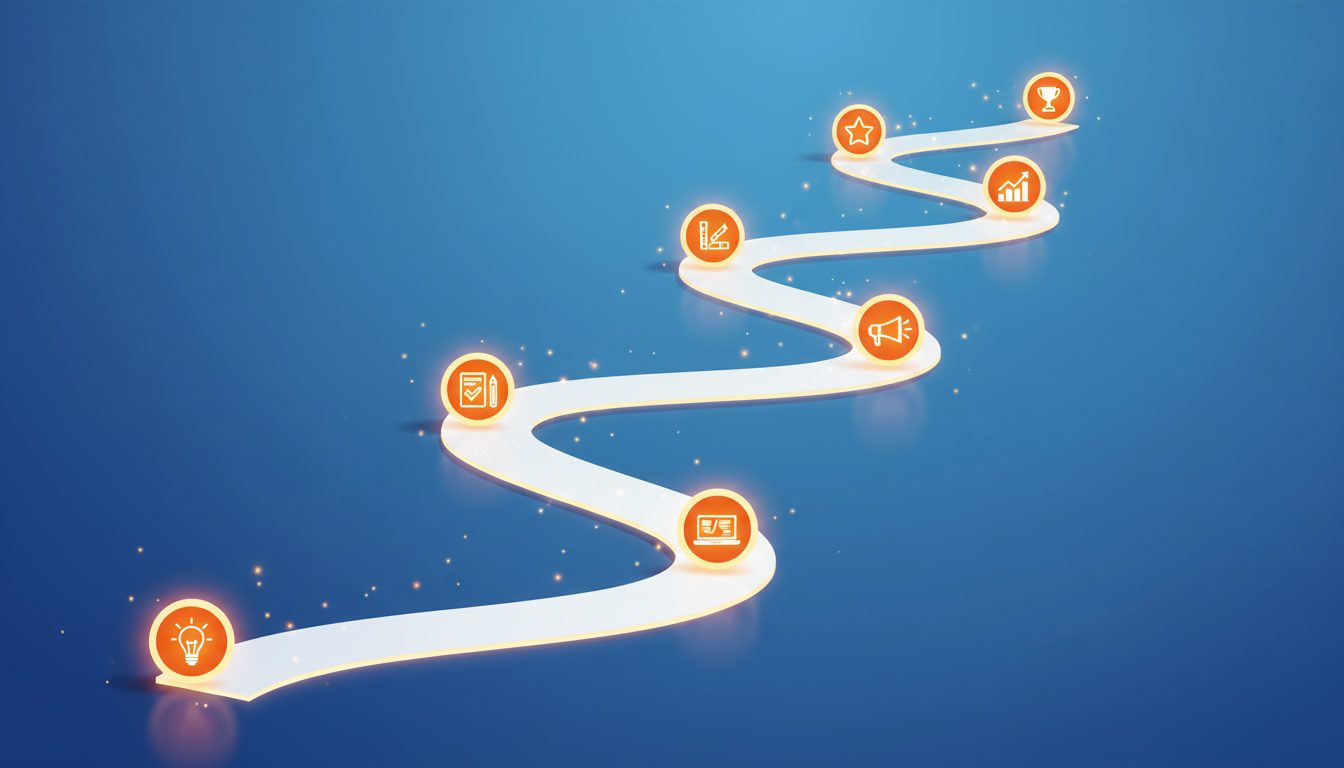
Creating your first lead magnet doesn't have to be complicated or time-consuming.
Here's exactly how to do it, step-by-step.
Step 1: Identify Your Patients' Biggest Problem (30 Minutes)
Don't guess. Use real data.
Review your patient intake forms from the last 3 months. What are the most common complaints? What brings people into your office most frequently?
Look for patterns. Maybe 40% of new patients mention desk-related back pain. Maybe headaches are a recurring theme. Maybe you see lots of sports injuries.
Pick one problem that affects a large segment of your target patients. You can create more lead magnets later. Right now, focus on the one that'll resonate with the most people.
Decision framework: Choose the problem that's both common (affects lots of people) and specific (you can solve it with a focused resource).
Step 2: Choose Your Lead Magnet Format (15 Minutes)
Match the format to the solution you're providing.
Use a checklist when: The solution involves following sequential steps or remembering multiple things.
Use a video when: Demonstrating proper form or technique is important (like stretches or exercises).
Use a quiz when: You want to engage people and segment them based on their needs.
Use a guide/PDF when: You're providing comprehensive information that people need to reference multiple times.
Start with whatever format you're most comfortable creating. A mediocre checklist you actually finish beats a perfect video you never complete.
Step 3: Create High-Value Content (2-3 Hours)
This is where most chiropractors overthink it.
Your lead magnet doesn't need to be comprehensive. It needs to be helpful. One quick win is worth more than ten theoretical benefits.
For checklists: List 5-10 specific, actionable items. Keep descriptions short—one sentence per item. Focus on what to do, not why to do it.
For videos: Script it first. Keep it under 10 minutes. Film in good lighting with clear audio. Your phone is perfectly fine—you don't need professional equipment.
For guides: Use simple language. Include visuals. Break information into scannable sections. Keep it to 3-5 pages maximum.
For quizzes: Write 7-10 questions that help identify their problem or need. Create 3-4 result categories with personalized recommendations for each.
Pro tip: Include one "implementation tip" that provides immediate relief. When someone gets results from your free content, booking an appointment becomes obvious.
Step 4: Design It Professionally (1-2 Hours)
Use Canva (free) to create professional-looking PDFs. They have tons of templates specifically for checklists, guides, and workbooks.
Design basics: Use your brand colors. Include your logo. Add your website and phone number. Keep it clean and uncluttered.
For videos: Edit on your phone or use free tools like iMovie. Add captions. Include your logo as a watermark. End with a clear call-to-action to visit your website.
Don't obsess over perfection. Done is better than perfect. Version 1.0 just needs to be good enough to provide value and look professional.
Step 5: Build a Dedicated Landing Page (1-2 Hours)
Create a simple landing page with these elements:
Compelling headline: State the benefit clearly. "Get Your Free 5-Minute Desk Stretch Routine" or "Download: The Complete Back Pain Relief Checklist"
3-5 bullet points: Explain what they'll get and why it's valuable.
Opt-in form: Ask ONLY for first name and email address. Every additional field you add reduces conversions.
Remove navigation: Dedicated landing pages shouldn't have menu bars or links away from the page. Focus on one goal: getting the email address.
Add trust elements: Include a photo of yourself, testimonials if you have them, or a simple statement like "Join 500+ local residents who've downloaded this guide."
Most website builders (DropFunnels, ClickFunnels, WordPress with plugins) make this easy. Or use standalone tools like ConvertKit or Leadpages.
Learn more about creating high-converting landing pages for chiropractic practices.
Step 6: Set Up Automated Email Delivery (30 Minutes)
Connect your landing page form to an email marketing platform (MailChimp, ConvertKit, Constant Contact, ActiveCampaign—pick one).
Create a welcome email sequence:
Email 1 (Immediate): Deliver the lead magnet. Welcome them. Set expectations for future emails.
Email 2 (2 days later): Check in. Ask if they've tried the tips. Provide one additional piece of value.
Email 3 (1 week later): Share a patient success story related to the lead magnet topic.
Email 4 (2 weeks later): Invite them to book a consultation. Include a clear call-to-action with your booking link.
Then: Continue sending valuable weekly emails—tips, success stories, answers to common questions.
Critical: Most people won't book immediately. The money is in the follow-up emails. Stay helpful, stay consistent, and be patient.
Learn more about creating effective lead magnet delivery systems.
Step 7: Promote Your Lead Magnet Everywhere (Ongoing)
Your lead magnet is worthless if nobody knows it exists.
On your website: Add a pop-up, header bar, or sidebar form promoting it. Feature it prominently on your homepage. Link to it from relevant blog posts.
On social media: Create posts highlighting the problem your lead magnet solves. Include a link to your landing page. Share it weekly—not everyone sees every post.
In your email signature: Add a P.S. with a link to your most popular lead magnet.
In local community: Share it in local Facebook groups. Partner with complementary businesses (gyms, yoga studios) to promote each other's resources.
Through paid ads: Even a small Facebook or Google Ads budget ($5-10/day) can drive consistent leads.
Step 8: Track Performance and Optimize (Monthly)
Monitor these key metrics:
Opt-in rate: How many landing page visitors enter their email? Target: 20-40%. Below 15% means your offer needs work.
Email open rates: Are people reading your follow-up emails? Target: 20-30%.
Click-through rates: Are people clicking links in your emails? Target: 2-5%.
Booking rate: Most important—how many leads eventually book appointments? Track this manually if needed.
Test different elements: Try different headlines, images, and calls-to-action. Even small changes can significantly impact conversions.
What to optimize: If opt-in rates are low, improve your headline or offer. If email open rates are low, work on subject lines. If people aren't booking, add more value in your email sequence or make the call-to-action clearer.
Where and How to Promote Your Lead Magnets
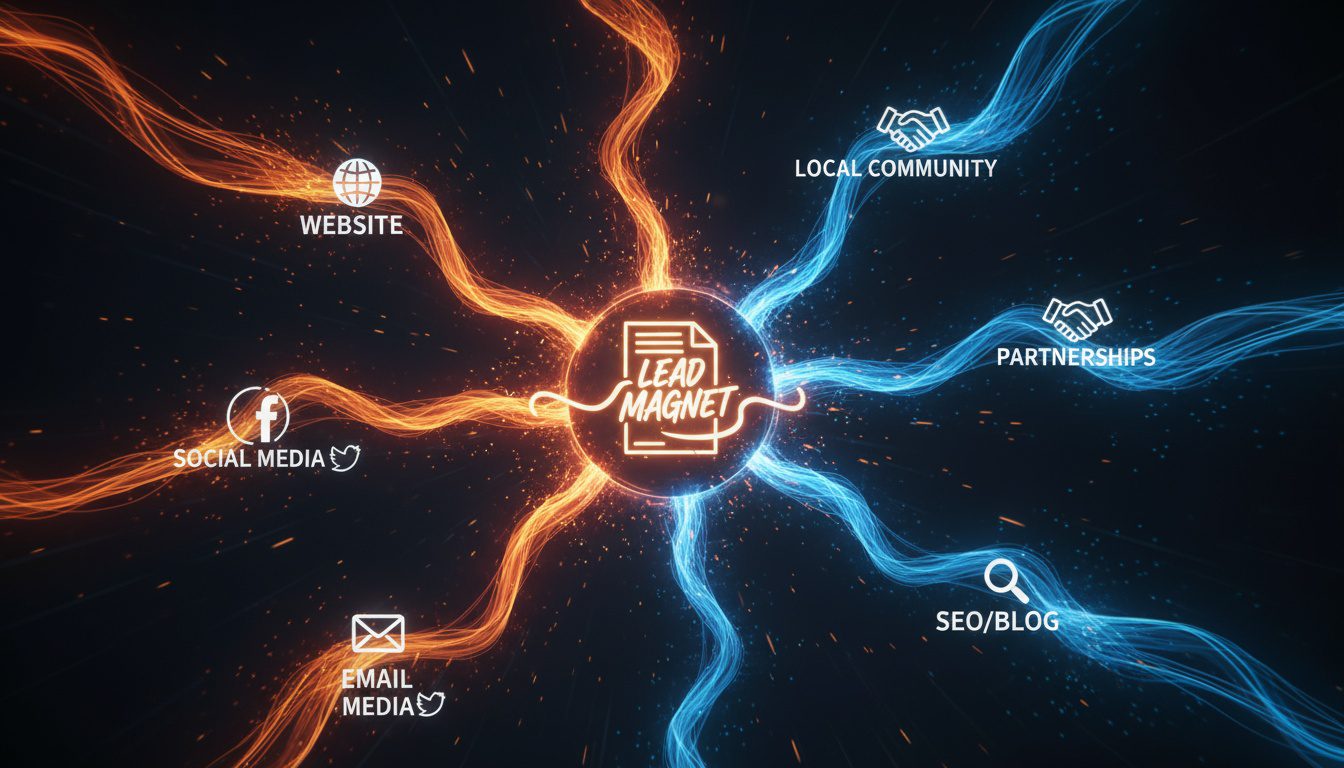
Creating a great lead magnet is only half the battle.
You need to get it in front of the right people. Here's exactly where and how to promote it for maximum impact.
On Your Website (Set It and Forget It)
Your website is prime real estate for lead magnet promotion.
Homepage: Feature your lead magnet prominently above the fold. Use a simple form or button that stands out visually.
Pop-up: Use a timed pop-up that appears after someone's been on your site for 10-15 seconds. Yes, some people hate pop-ups. But they work—conversion rates prove it.
Header bar: Add a persistent header bar at the top of your site promoting your lead magnet. Make it dismissible but visible on every page.
Blog posts: At the end of every relevant blog post, include a call-to-action for your lead magnet. If your post is about headaches, offer your headache tracker. If it's about posture, offer your posture guide.
Exit intent: Use exit-intent technology that triggers an offer when someone's about to leave your site. "Wait! Before you go, grab your free back pain relief checklist."
On Social Media Platforms (Consistent Presence)
Don't just post "Download my free guide!" Nobody cares about your guide. They care about their problems.
Instead, lead with the problem:
"Does your back ache after sitting at your desk all day? You're not alone—and there are simple adjustments you can make right now to feel better. I put together a free guide showing exactly how to set up your workspace to prevent pain. Link in bio."
Post frequency: Share your lead magnet weekly across all platforms. Rotate the messaging and visuals so it doesn't feel repetitive.
Platform-specific tips:
Facebook: Share in your local community groups (where allowed). Create a short video explaining the problem and mentioning the lead magnet as the solution.
Instagram: Use Stories with swipe-up links (if you have enough followers) or link in bio. Create carousel posts showing tips from your lead magnet.
LinkedIn: Perfect for office worker-focused lead magnets. Write short posts about desk ergonomics or work-related pain, then mention your resource.
YouTube: Create valuable content videos, then mention your lead magnet in the video and include a link in the description.
Through Email Marketing (Leverage Your Existing List)
Don't forget about the people already on your email list.
Send an email to your existing subscribers promoting your new lead magnet. Some of them might not have seen it. Others might want to share it with friends who need help.
Include a forward-to-a-friend option: Make it easy for patients to share your resources with people they know who are struggling with pain.
Add your lead magnet links to your email signature. Every email you send becomes a promotional opportunity.
Through Local Community Partnerships (Offline and Online)
Partner with businesses that serve your ideal patients:
Gyms and fitness studios: They see people with muscle strain and sports injuries daily. Offer to provide their members with your injury prevention guides.
Yoga and pilates studios: Perfect for posture and flexibility resources.
Coffee shops and coworking spaces: Great for reaching remote workers with desk setup guides.
Running clubs and sports teams: Share sport-specific injury prevention resources.
Ask these partners to: Share your lead magnet with their email list, post about it on social media, display QR code flyers in their space, or mention it during classes or events.
Make it win-win: Offer to promote their business to your email list in return. Or provide their members/clients with an exclusive bonus along with your lead magnet.
Through Paid Advertising (Accelerated Growth)
Organic promotion is great, but paid ads can dramatically accelerate your lead generation.
Facebook and Instagram Ads:
Target: People within 10-15 miles of your practice, ages 30-65, interested in health and wellness.
Budget: Start with $5-10/day. Test different audiences and ad creative.
Format: Video ads showing you demonstrating tips usually outperform static images.
Google Ads:
Target keywords: "back pain relief [your city]," "chiropractor near me," "posture correction," etc.
Budget: Competitive, so start at $10-15/day minimum.
Landing page: Send ad traffic directly to your lead magnet landing page, not your homepage.
Retargeting ads: Show ads for your lead magnet to people who've visited your website but didn't opt in. These people are already familiar with you and convert at higher rates.
Learn more about using Google Ads for chiropractic practices.
How to Turn Downloaded Lead Magnets Into Booked Appointments
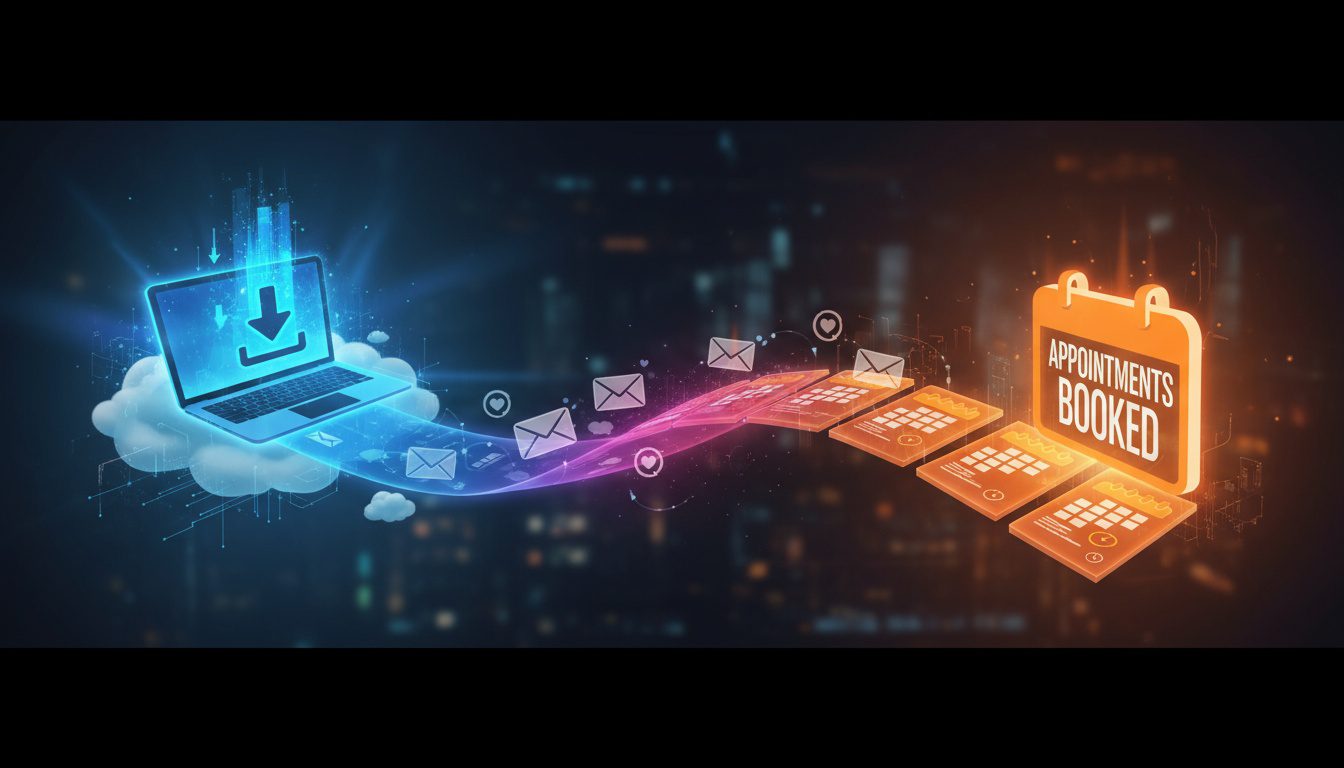
Getting people to download your lead magnet is just the beginning.
The real money is in converting those leads into paying patients. Here's how to do it without being pushy or salesy.
Deliver Immediate Value (The Foundation of Trust)
The second someone opts in, they should receive your lead magnet automatically.
Your delivery email should:
Subject line: "Your [Lead Magnet Name] is Ready"
Opening: Thank them for downloading. Confirm they'll find the resource helpful.
Delivery: Provide a clear, obvious download link or button.
Next step: Tell them what to do next. "Try the 5-minute routine tomorrow morning and notice how your body feels."
Set expectations: "Over the next few weeks, I'll send you helpful tips about [topic]. You can unsubscribe anytime, but I promise to only send valuable content—no spam."
Call-to-action: Include a soft CTA like, "If you're dealing with chronic pain and want personalized help, you can schedule a consultation here."
Critical: Don't oversell in this first email. They just gave you their email address. Prove you're trustworthy by delivering exactly what you promised with zero pressure.
Follow Up with a Value-Driven Email Sequence
Most chiropractors fail at follow-up. They send the lead magnet, then nothing. Or they immediately start pushing for appointments.
Both approaches lose money.
Here's a proven 6-email sequence that converts:
Email 1 (Immediate): Deliver lead magnet + set expectations.
Email 2 (Day 2): "Did you try [technique from lead magnet]? Here's one more tip that works even better." Provide additional value. No sales pitch.
Email 3 (Day 5): Share a patient success story. "When Sarah came to our practice, she was dealing with the same desk-related back pain you might be experiencing. Here's what happened..." End with soft CTA to book a consultation.
Email 4 (Day 9): Educational content. Answer a common question related to the lead magnet topic. Position yourself as the expert without selling.
Email 5 (Day 14): "3 Signs It's Time to See a Chiropractor." Help them understand when self-help isn't enough and professional care is needed. Include booking link.
Email 6 (Day 21): Clear, direct invitation to book. "I've loved sharing these tips with you. If you're ready for personalized care that addresses your specific situation, I'd love to help. Here's how to schedule your first appointment."
After that: Continue sending valuable weekly emails—tips, success stories, office news, answers to questions. Stay top-of-mind without being pushy.
Make Booking as Easy as Possible
Every obstacle you put between "ready to book" and "appointment scheduled" costs you patients.
Use online scheduling: Let people book 24/7 without calling. Include your online scheduling link in every email and on every page of your website.
Offer flexible appointment times: Early mornings, evenings, and Saturdays capture people who can't come during traditional hours.
Reduce risk: Offer a "New Patient Special" or "Consultation + First Adjustment" package at a discounted rate. Remove the financial barrier for first-time patients.
Clear next steps: Don't assume people know what to do. "Click here to see available appointments" is better than "Contact us to schedule."
Learn more about attracting and converting new chiropractic patients.
Segment Your Leads and Personalize Communication
Not all leads are the same. Someone who downloaded your sports injury guide has different needs than someone who grabbed your desk worker posture guide.
Tag your leads based on which lead magnet they downloaded. This lets you send targeted follow-up content.
Example: Someone who downloaded your headache tracker gets emails about headache triggers, migraine prevention, and stress management. Someone who downloaded your running injury prevention guide gets emails about sports performance, recovery, and training tips.
Personalized communication converts way better than generic blasts. It shows you understand their specific situation.
Most email marketing platforms (ActiveCampaign, ConvertKit, MailChimp) make this easy with tags and automation.
Track Which Lead Magnets Bring Paying Patients
Not all lead magnets convert equally well.
Track these metrics for each lead magnet:
Total downloads: How many people are opting in?
Email engagement: Are people opening emails and clicking links?
Booking rate: Most important—how many leads eventually book appointments?
Patient lifetime value: Which lead magnets attract patients who stick around longest?
Maybe your back pain checklist gets tons of downloads but few bookings. Meanwhile your free posture assessment generates fewer leads but 40% of them book appointments.
Double down on what works. Create more lead magnets similar to your winners. Improve or replace underperformers.
Stay Patient and Consistent
Here's the hardest truth about lead magnets: Most people won't book immediately.
The average person needs 30-90 days from first contact to booking decision. Some take even longer.
Your job is to stay helpful, stay present, and stay patient. Keep sending valuable weekly emails. Keep demonstrating your expertise. Keep showing them you understand their problems.
Then when their pain gets worse, when their friend asks for a chiropractor recommendation, when they finally decide they're tired of living with discomfort, you're the obvious choice.
The chiropractors who win aren't the ones with the best ads or the fanciest websites. They're the ones who build relationships and stay consistent.
Frequently Asked Questions About Chiropractic Lead Magnets
What makes a good lead magnet for a chiropractic practice?
The best chiropractic lead magnets solve specific problems your ideal patients face before they're ready to book appointments. Focus on actionable content like "5 Exercises to Reduce Lower Back Pain at Work" or "The Complete Guide to Choosing a Chiropractor."
Avoid generic topics—address the exact concerns and questions you hear most often during consultations. The content should provide immediate value while demonstrating your expertise.
Think specificity over comprehensiveness. A one-page checklist that solves one problem beats a 40-page ebook that tries to cover everything. You want people to think, "This is exactly what I needed right now."
The best lead magnets are also instantly accessible. Digital formats that can be delivered immediately via email perform best. People want help now, not next week.
Should I offer different lead magnets for different patient types?
Yes, absolutely. Segmenting lead magnets by patient type dramatically improves conversion rates.
Create separate offers for:
Office workers: Posture guides, desk ergonomics, "tech neck" solutions
Athletes: Sports-specific injury prevention, recovery protocols, performance optimization
Pregnant women: Prenatal chiropractic care information, safe exercises, labor preparation
Seniors: Mobility maintenance, fall prevention, joint health guides
Parents: Pediatric chiropractic benefits, family wellness resources
Each segment has different pain points and responds to different solutions. A marathon runner doesn't care about your desk posture guide. An office worker isn't interested in sports injury prevention.
Start with one lead magnet for your most common patient type, then expand as you have time and resources. Three targeted lead magnets will outperform one generic resource every time.
How do I promote my lead magnets without seeming pushy or salesy?
Frame your lead magnets as helpful resources rather than marketing tools. Use language that emphasizes helping over selling.
Instead of "Get our lead magnet," say "Grab your free guide" or "Download these helpful tips."
Lead with the problem, not the solution: "Does your back ache after long days at your desk? Here's a free resource that shows you exactly how to set up your workspace to prevent pain."
Promote them naturally in places where they're relevant:
In blog posts: At the end of posts about back pain, mention your back pain relief checklist as additional helpful information.
During patient conversations: When patients ask questions you've addressed in a lead magnet, mention it: "Actually, I created a guide that goes into more detail about this. I'll send you the link—it's free."
On social media: Share helpful tips, then mention your lead magnet as a more comprehensive resource for people who want to dive deeper.
The key is to always lead with value. Help first, ask later. When you're genuinely helpful, people naturally want to work with you.
What's the ideal length for a chiropractic lead magnet?
Shorter is usually better. A one-page checklist often converts better than a 50-page ebook because it's instantly actionable and doesn't feel overwhelming.
Aim for content that takes 5-10 minutes to consume. People are busy. They want quick wins, not homework.
Format-specific guidelines:
Checklists: 1-2 pages maximum
Guides/PDFs: 3-5 pages
Videos: 5-10 minutes
Quizzes: 7-10 questions
Webinars: 20-30 minutes
The goal is to provide a quick win that builds trust, not a comprehensive textbook. Focus on depth of usefulness rather than length.
One exception: If you're targeting people doing serious research (like choosing between different treatment approaches), a more comprehensive guide can work well. But for most chiropractic lead magnets, shorter and more focused wins.
Should I gate all my valuable content behind lead magnets, or give some away for free?
Strike a balance. Share helpful tips and insights freely through blog posts and social media to build trust and demonstrate expertise.
Reserve your most comprehensive, actionable content—like detailed guides, exercise videos, or step-by-step protocols—as lead magnets.
Free content builds trust. Lead magnets capture interested prospects and allow deeper relationship building.
Think of it like this: Your blog posts and social media content are the samples that prove you know your stuff. Your lead magnets are the "next level" resources for people ready to take action.
Good free content: "5 Tips for Better Posture at Your Desk" (blog post)
Good lead magnet: "The Complete Desk Worker's Posture Reset Guide with Photos and Daily Checklist" (downloadable PDF)
See the difference? Both are valuable. But the lead magnet is more comprehensive, more actionable, and more valuable—worth exchanging an email address to access.
You can also repurpose the same content. Turn a detailed blog post into a prettier, more comprehensive PDF that people can download and keep for reference.
How many lead magnets should I create for my practice?
Start with one high-quality lead magnet that addresses your patients' biggest concern, then expand gradually over time.
Most successful practices have 3-5 lead magnets targeting different patient types or problems:
- General back pain resource (broad appeal)
- Posture/desk work guide (office workers)
- Specific condition guide (headaches, sciatica, sports injuries—whatever you see most)
- New patient offer or consultation incentive (people ready to book)
- Specialty resource (if you have a niche—pregnancy, pediatrics, athletes, etc.)
Don't try to create them all at once. Launch one, promote it for 2-3 months, analyze what works, then create the next one.
Update content annually or when information changes, but focus more on creating new magnets than constantly revising existing ones. Quality and relevance matter more than quantity.
One excellent lead magnet promoted consistently will bring in more leads than five mediocre ones that nobody knows about.
What conversion rate should I expect from my lead magnets?
A well-designed lead magnet landing page should convert between 20-40% of visitors.
If you're below 15%, your offer might not be specific enough, valuable enough, or you might be asking for too much information in your form.
Above 40% means you've nailed the problem-solution match and have strong messaging. Some interactive lead magnets (quizzes, assessments) can hit 50-60% conversion rates.
But here's what really matters: How many leads eventually book appointments?
That's the metric that actually impacts your practice. You could have a 50% opt-in rate, but if only 2% of leads book appointments, something's broken in your follow-up process.
Track both metrics:
Opt-in rate: Are people downloading your lead magnet?
Lead-to-patient rate: Are downloads turning into appointments?
A 25% opt-in rate with a 10% booking rate (meaning 2.5% of all visitors eventually book) is way more valuable than a 50% opt-in rate with a 2% booking rate (only 1% of visitors book).
Focus on both metrics, but optimize for bookings, not just downloads.
How quickly should I follow up after someone downloads my lead magnet?
Deliver the lead magnet instantly via automated email. No delays. No "we'll send it within 24 hours." Immediate delivery.
Follow up within 24 hours with a personal welcome email that provides additional value and invites them to book a consultation if they want personalized help.
Then nurture them with weekly emails for 4-6 weeks: helpful tips, patient success stories, educational content, and periodic invitations to book.
Here's the critical part most chiropractors miss: Most people won't book immediately. The average lead needs 30-90 days and multiple touchpoints before booking.
Your email sequence should:
Week 1: Welcome + additional value, no hard sell
Week 2-3: Educational content + soft CTA to book
Week 4-5: Success stories + clearer booking invitation
Week 6+: Mix of value content and booking reminders
After 6 weeks: Continue weekly valuable emails indefinitely. Staying top-of-mind means you're their first call when they're ready.
Some practices see the best results from a 12-email sequence over 90 days. Test different approaches and see what works for your audience.
The key is being consistently helpful without being annoying. Provide value in every email, not just sales pitches.
Conclusion: Your Lead Magnet Strategy Starts Now

Stop waiting for the phone to ring and take control of your patient acquisition.
You now have everything you need to create lead magnets that actually fill your schedule. The templates. The examples. The step-by-step process. The promotion strategies.
Here's what separates chiropractors who grow from those who struggle: Successful practices capture interested prospects and nurture them until they're ready to book. Struggling practices hope people will book immediately, then wonder why their phone stays quiet.
Effective chiropractic lead magnets transform your marketing from reactive to proactive. Instead of hoping potential patients will find and immediately trust you, you're actively building relationships with people who need your expertise but aren't quite ready yet.
Each lead magnet creates a bridge between your knowledge and the patients who need it most. You're not just collecting email addresses; you're building a community of people who see you as their trusted chiropractic expert.
When they're finally ready for care—or when someone they know needs help—you'll be the obvious choice. Not because you ran more ads. Not because you have the fanciest website. Because you've already proven you understand their problems and know how to solve them.
Start Simple, Start Now
You don't need to implement everything at once.
Here's your action plan for the next 7 days:
Day 1-2: Choose one lead magnet idea from this guide. Pick the one that addresses your patients' most common complaint.
Day 3-4: Create the content. Don't overthink it. Done is better than perfect. Focus on being genuinely helpful.
Day 5: Design it using Canva or a simple template. Add your branding and contact information.
Day 6: Build a landing page and set up automated email delivery.
Day 7: Start promoting it on your website and social media.
That's it. One week from now, you can have your first lead magnet working for you 24/7, attracting qualified prospects while you sleep, see patients, or enjoy time with family.
Then watch what happens over the next 90 days. The leads start coming in. Your email list grows. People start recognizing your name in the community. Your schedule fills with patients who already trust you before their first appointment.
And here's the best part: Once you've created one successful lead magnet, creating the next one is way easier. You know the process. You understand what works. You can scale up your lead generation systematically.
The chiropractors filling their practices aren't smarter than you. They're not working harder. They're just capturing leads instead of letting them disappear.
Ready to stop losing potential patients to competitors? Create your first lead magnet this week.
Free website audit — manual audit with a Loom video (up to ~10 minutes) delivered within 24 hours of opt-in; includes an immediate case study after opting in.

Gerek Allen
Co-Owner iTech Valet
Entrepreneur, patriot, CrossFit junkie, IPA enthusiast, loves to travel to tropical destinations, and knows way too many movie quotes.
About iTech Valet
iTech Valet specializes in web design and content marketing for online entrepreneurs who want to share their expertise.
Services Include:
- Web Design
- Graphic Design
- Sales Copy
- Funnel Building
- Authority Sites
- Membership Sites
- Course Creation
- Email Systems
- Content Marketing
- Competitive Analysis
- Tech Integrations
- Strategic Planning


